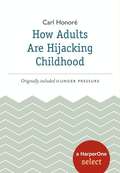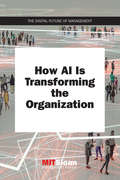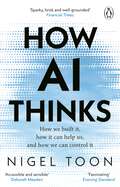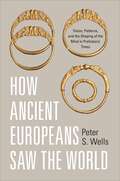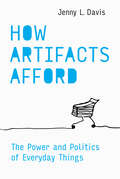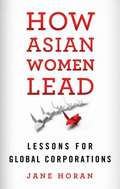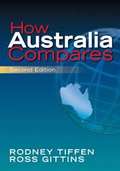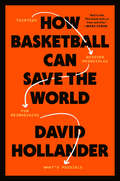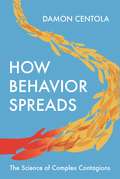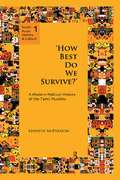- Table View
- List View
How About Demons?: Possession and Exorcism in the Modern World (Folklore Today #No.467)
by Felicitas D. GoodmanThe author of the Exorcism of Anneliese Michel &“is to be commended for a stimulating and wide-reaching treatment of a compelling and much-debated subject&” (Journal of Folklore Research). As part of a series that strives to introduce new or previously unrecognized folkloric phenomena—as well as new approaches and theories that result from discovery and investigation—How About Demons? provides an overview of a topic that has for many years captured the imagination of people from all walks of life. Rich in detail derived from the author&’s fieldwork and anthropological literature, this work contemplates possession and exorcism in a holistic manner—discussing their effects on both the body and soul. How About Demons? paints a picture of possession as a usually positive experience occurring in a wide variety of cultures and religions around the globe. It also details the ritual of exorcism which is applied when things go wrong. &“Quite an interesting book.&”—Religious Studies Review &“It is by far superior to anything else on demons we have seen in the past few years.&”—The American Rationalist
How Adults Are Hijacking Childhood
by Carl HonoreThis selection from Carl Honore's Under Pressure explores the history of childhood, including social trends and cultural movements that have contributed to the current practice of hyperparenting. In How Adults Are Ruining Childhood bestselling author Carl Honore explores the contradictions inherent in modern parenting. We want children to strive for high-achieving adulthood while also enjoying a childhood full of joy and free of danger. We tell our children to "grow up" and then bristle when they do. We expect them to ful?ll our dreams and yet remain true to themselves. The common thread, of course, is that through the ages children have never chosen their own childhood. Adults have always called the tune. Today it seems to be more about the adults than ever.
How AI Is Transforming the Organization (The Digital Future of Management)
by MIT Sloan Management ReviewA clear-eyed look at how AI can complement (rather than eliminate) human jobs, with real-world examples from companies that range from Netflix to Walmart.Descriptions of AI's possible effects on businesses and their employees cycle between utopian hype and alarmist doomsaying. This book from MIT Sloan Management Review avoids both these extremes, providing instead a clear-eyed look at how AI can complement (rather than eliminate) human jobs, with real-world examples from companies that range from Netflix to Walmart. The contributors show that organizations can create business value with AI by cooperating with it rather than relinquishing control to it. The smartest companies know that they don't need AI that mimics humans because they already have access to resources with human capability—actual humans.The book acknowledges the prominent role of such leading technology companies as Facebook, Apple, Amazon, Netflix, and Google in applying AI to their businesses, but it goes beyond the FAANG cohort to look at AI applications in many nontechnology companies, including DHL and Fidelity. The chapters address such topics as retraining workers (who may be more ready for change than their companies are); the importance of motivated and knowledgeable leaders; the danger that AI will entrench less-than-ideal legacy processes; ways that AI could promote gender equality and diversity; AI and the global loneliness epidemic; and the benefits of robot–human collaboration. ContributorsCynthia M. Beath, Megan Beck, Joe Biron, Erik Brynjolfsson, Jacques Bughin, Rumman Chowdhury, Paul R. Daugherty, Thomas H. Davenport, Chris DeBrusk, Berkeley J. Dietvorst, Janet Foutty, James R. Freeland, R. Edward Freeman, Julian Friedland, Lynda Gratton, Francis Hintermann, Vivek Katyal, David Kiron, Frieda Klotz, Jonathan Lang, Barry Libert, Paul Michelman, Daniel Rock, Sam Ransbotham, Jeanne W. Ross, Eva Sage-Gavin, Chad Syverson, Monideepa Tarafdar, Gregory Unruh, Madhu Vazirani, H. James Wilson
How AI Thinks: How we built it, how it can help us, and how we can control it
by Nigel ToonTHE #2 TIMES BESTSELLER'Artificial intelligence is going to have a massive impact on everyone’s lives... an accessible and sensible read that helps demystify AI' Deborah Meaden, entrepreneur and star of Dragon's Den'Nigel Toon is a visionary leader in the field of artificial intelligence... a must-read' Marc Tremblay, Distinguished Engineer, MicrosoftThose who understand how AI thinks are about to win big.We are used to thinking of computers as being a step up from calculators - very good at storing information, and maybe even at playing a logical game like chess. But up to now they haven't been able to think in ways that are intuitive, or respond to questions as a human might. All that has changed, dramatically, in the past few years.Our search engines are becoming answer engines. Artificial intelligence is already revolutionising sectors from education to healthcare to the creative arts. But how does an AI understand sentiment or context? How does it play and win games that have an almost infinite number of moves? And how can we work with AI to produce insights and innovations that are beyond human capacity, from writing code in an instant to unfolding the elaborate 3D puzzles of proteins?We stand at the brink of a historic change that will disrupt society and at the same time create enormous opportunities for those who understand how AI thinks. Nigel Toon shows how we train AI to train itself, so that it can paint images that have never existed before or converse in any language. In doing so he reveals the strange and fascinating ways that humans think, too, as we learn how to live in a world shared by machine intelligences of our own creation.
How All Politics Became Reproductive Politics: From Welfare Reform to Foreclosure to Trump (Reproductive Justice: A New Vision for the 21st Century #2)
by Laura BriggsToday all politics are reproductive politics, argues esteemed feminist critic Laura Briggs. From longer work hours to the election of Donald Trump, our current political crisis is above all about reproduction. Households are where we face our economic realities as social safety nets get cut and wages decline. Briggs brilliantly outlines how politicians’ racist accounts of reproduction—stories of Black “welfare queens” and Latina “breeding machines"—were the leading wedge in the government and business disinvestment in families. With decreasing wages, rising McJobs, and no resources for family care, our households have grown ever more precarious over the past forty years in sharply race-and class-stratified ways. This crisis, argues Briggs, fuels all others—from immigration to gay marriage, anti-feminism to the rise of the Tea Party.
How America Compares (How the World Compares)
by Rodney Tiffen Anika Gauja Brendon O'Connor Ross Gittins David SmithThis book is a reference work with an encyclopedic range, offering contemporary and systematic comparisons between the United States and 17 other economically advanced, stable liberal democracies, as well as some more global comparisons. It offers international data on as many aspects of social life as possible, from taxation to traffic accidents, homicide rates to health expenditure, and interest rates to internet usage. Wherever possible, it offers not only the most recent available data but also trends over decades. The discussion focuses on changes over time and comparisons between countries. Sometimes the contrasts are striking; sometimes the commonalities are more instructive. Often national political debates are conducted in a vacuum, and examining comparative data on policies, performance, and prospects can give a better perspective.
How Americans Make Race
by Clarissa Rile HaywardHow do people produce and reproduce identities? In Stories and Spaces, Clarissa Rile Hayward challenges what is sometimes called the "narrative identity thesis": the idea that people produce and reproduce identities as stories. Identities have greater staying power than one would expect them to have if they were purely and simply narrative constructions, she argues, because people institutionalize identity-stories, building them into laws, rules, and other institutions that give social actors incentives to perform their identities well, and because they objectify identity-stories, building them into material forms that actors experience with their bodies. Drawing on in-depth historical analyses of the development of racialized identities and spaces in the twentieth-century United States, and also on life-narratives collected from people who live in racialized urban and suburban spaces, Hayward shows how the institutionalization and objectification of racial identity-stories enables their practical reproduction, lending them resilience in the face of challenge and critique.
How an Island Lost Its People: Improvement, Clearance and Resettlement on Lismore 1830–1914
by Robert HayIn 1830, the little Hebridean island of Lismore was one of the granaries of the West Highlands, with every possible scrap of land producing bere barley or oats. The population had reached its peak of 1500, but by 1910, numbers had dwindled to 400 and were still falling. The agricultural economy had been almost completely transformed to support sheep and cattle, with ploughland replaced by the now familiar green grassy landscape. With reference to documentary sources, including Poor Law reports, the report of the Napier Commission into the condition crofters in the Highlands and Islands, as well as local documents and letters, this book documents a century of emigration, migration and clearance and paints an intimate portrait of the island community during a period of profound change. At the same time, it also celebrates the achievements of the many tenants who grasped the opportunities involved in agricultural improvement.
How Ancient Europeans Saw the World: Vision, Patterns, and the Shaping of the Mind in Prehistoric Times
by Peter S. WellsA revolutionary approach to how we view Europe's prehistoric cultureThe peoples who inhabited Europe during the two millennia before the Roman conquests had established urban centers, large-scale production of goods such as pottery and iron tools, a money economy, and elaborate rituals and ceremonies. Yet as Peter Wells argues here, the visual world of these late prehistoric communities was profoundly different from those of ancient Rome's literate civilization and today's industrialized societies. Drawing on startling new research in neuroscience and cognitive psychology, Wells reconstructs how the peoples of pre-Roman Europe saw the world and their place in it. He sheds new light on how they communicated their thoughts, feelings, and visual perceptions through the everyday tools they shaped, the pottery and metal ornaments they decorated, and the arrangements of objects they made in their ritual places—and how these forms and patterns in turn shaped their experience.How Ancient Europeans Saw the World offers a completely new approach to the study of Bronze Age and Iron Age Europe, and represents a major challenge to existing views about prehistoric cultures. The book demonstrates why we cannot interpret the structures that Europe's pre-Roman inhabitants built in the landscape, the ways they arranged their settlements and burial sites, or the complex patterning of their art on the basis of what these things look like to us. Rather, we must view these objects and visual patterns as they were meant to be seen by the ancient peoples who fashioned them.
How Artifacts Afford: The Power and Politics of Everyday Things (Design Thinking, Design Theory)
by Jenny L. DavisA conceptual update of affordance theory that introduces the mechanisms and conditions framework, providing a vocabulary and critical perspective. Technological affordances mediate between the features of a technology and the outcomes of engagement with that technology. The concept of affordances, which migrated from psychology to design with Donald Norman's influential 1988 book, The Design of Everyday Things, offers a useful analytical tool in technology studies--but, Jenny Davis argues in How Artifacts Afford, it is in need of a conceptual update. Davis provides just such an update, introducing the mechanisms and conditions framework, which offers both a vocabulary and necessary critical perspective for affordance analyses.
How Asian Women Lead
by Jane HoranHow Asian Women Lead provides a vastly different picture than Western-focused leadership literature, highlighting obstacles Asian women face reaching the top, and looking beneath the corporate surface to show cultural and family perspectives.
How Australia Compares
by Rodney Tiffen Ross GittinsHow Australia Compares is a handy reference that compares Australia with 17 other developed countries across a wide range of social, economic and political dimensions. Whenever possible, it gives not only snapshot comparisons from the present, but charts trends over recent decades or even longer. Encyclopaedic in scope, it provides statistics for a huge range of human activity, from taxation to traffic accidents, homicide rates to health expenditure, interest rates to internet usage. This new edition is fully revised and updated, and features two new chapters: The Howard Impact and The Search for Scoreboards. New sections include obesity, advertising, broadband internet access, childcare and corruption. Information is highly accessible with double-page spreads for each topic. Tables and graphs are presented on one page, and clear explanation and analysis on the facing page. In each discussion the focus is to put the Australian experience into international perspective, drawing out the implications for the nation's performance, policies and prospects.
How Australia Decides
by Sally YoungIn recent years, the Australian media have come under fire for their reporting of politics and election campaigns. Political reporting is said to be too influenced by commercial concerns, too obsessed with gossip and scandal, and too focused on trivia and 'sound bites' at the expense of serious issues. There are accusations of bias, sensationalism, 'lazy' journalism and 'horse-race' reporting that is obsessed with opinion polls. How Australia Decides is the first book to put these allegations to the test. Based on a four-year empirical study, Sally Young reports the results of the only systematic, historical and in-depth analysis of Australian election reporting. This groundbreaking book shows how election reporting has changed over time, and how political news audiences, news production and shifts in political campaigning are influencing media content, Ai with profound implications for Australian democracy.
How Basketball Can Save the World: 13 Guiding Principles for Reimagining What's Possible
by David HollanderA thought-provoking exploration of how basketball—and the values rooted in the game—can solve today&’s most pressing issues, from the professor behind the popular New York University courseNBA and WNBA superstars, Hall of Fame players, coaches, and leading cultural figures have all dropped by New York University Professor David Hollander&’s course &“How Basketball Can Save the World&” course to debate and give insights on how the underlying principles of the game can provide a new blueprint for addressing our diverse challenges and showing what&’s possible beyond the court.Now, in How Basketball Can Save the World, Hollander takes us out of the classroom to present a beautiful new philosophy with contributions by many of his past guests and based on values inherent to basketball, such as inclusion and the balancing of individual success with the needs of the collective. These principles move us beyond conflict and confusion toward a more harmonious and meaningful future:Positionless-ness: In basketball, players aren&’t siloed into just one position or responsibility. In life, we can learn to be more adaptive to the challenges we face by embracing a positionless mindset.Human Alchemy: We talk a lot about team chemistry, but team alchemy means the creation of something totally new—a team far greater than the sum of its parts.Sanctuary: Basketball offers players a critical space to feel safe, free, and expressive. Fostering similar spaces in the real world can encourage people to be their best, happiest, and most productive selves.Transcendence: Basketball is about defying gravity, becoming weightless, and flying higher than anyone ever has before. By seeking out this principle, we can elevate ourselves and those around us to a new plane of experience.Whether you&’re a seasoned veteran of the game or have never set foot on a court, How Basketball Can Save the World will empower you to become more resilient, tolerant, and wise in your relationship with yourself, others, and the world around you.
How Behavior Spreads: The Science of Complex Contagions (Princeton Analytical Sociology Series #3)
by Damon CentolaA new, counterintuitive theory for how social networks influence the spread of behaviorNew social movements, technologies, and public-health initiatives often struggle to take off, yet many diseases disperse rapidly without issue. Can the lessons learned from the viral diffusion of diseases be used to improve the spread of beneficial behaviors and innovations? In How Behavior Spreads, Damon Centola presents over a decade of original research examining how changes in societal behavior--in voting, health, technology, and finance—occur and the ways social networks can be used to influence how they propagate. Centola's startling findings show that the same conditions accelerating the viral expansion of an epidemic unexpectedly inhibit the spread of behaviors. While it is commonly believed that "weak ties"—long-distance connections linking acquaintances—lead to the quicker spread of behaviors, in fact the exact opposite holds true. Centola demonstrates how the most well-known, intuitive ideas about social networks have caused past diffusion efforts to fail, and how such efforts might succeed in the future. Pioneering the use of Web-based methods to understand how changes in people's social networks alter their behaviors, Centola illustrates the ways in which these insights can be applied to solve countless problems of organizational change, cultural evolution, and social innovation. His findings offer important lessons for public health workers, entrepreneurs, and activists looking to harness networks for social change.Practical and informative, How Behavior Spreads is a must-read for anyone interested in how the theory of social networks can transform our world.
'How Best Do We Survive?': A Modern Political History of the Tamil Muslims (South Asian History and Culture)
by Kenneth McPhersonThis book traces the social and political history of the Muslims of south India from the later nineteenth century to Independence in 1947, and the contours that followed. It describes a community in search of political survival amidst an ever-changing climate, and the fluctuating fortunes it had in dealing with the rise of Indian nationalism, the local political nuances of that rise, and its own changing position as part of the wider Muslim community in India. The book argues that Partition and the foundation of Pakistan in 1947 were neither the goal nor the necessarily inescapable result of the growth of communal politics and sentiment, and analyses the post-1947 constructions of events leading to Partition. Neither the fact of Muslim communalism per se before 1947 nor the existence of separate Muslim electorates provide an explanation for Pakistan. The book advances the theory that micro-level studies of the operation of the former, and the defence of the latter, in British India can lead to a better understanding of the origins of communalism. The book makes an important contribution to understanding and dealing with the complexities of communalism — be it Hindu, Muslim or Christian — and its often tragic consequences.
How Big And Still Beautiful?: Macro- Engineering Revisited
by Frank P. DavidsonThis volume examines fundamental issues of macro-engineering—now a planetary norm—from the viewpoints of psychiatry, social science, management, and law. The contributors suggest a general theory to guide future decisions on large-scale projects and programs and analyze specific cases in the context of a set of public-interest guidelines.
How Black History Can Save Your Life: Belonging at the Breaking Point
by Ernest Crim IIIBlack History's Power to Combat RacismHow Black History Can Save Your Life by Ernest Crim III, a hate crime survivor and Anti-Racist Educator, is an essential guide for anyone seeking to combat interpersonal racism, understand the roots of discrimination, and gain actionable strategies through Black historical narratives. This black history book for adults book empowers individuals, parents, and educators with tools to challenge racism and foster equity in their communities.Using Black history to fight racism. This book builds on Crim's personal experiences, including a viral 2016 hate crime incident that profoundly shaped his career. During a night out, Crim was targeted with racial slurs, but instead of letting it defeat him, he used the situation to highlight the pervasive nature of racism in America. He captured the moment on video, sparking a national conversation about the importance of confronting and addressing discrimination. Reclaiming the stories of Black history. Crim delves deep into the stories of Black excellence, resistance, and perseverance. He equips families, parents, and educators with the tools they need to combat racism in everyday life and within schools. Through his lens as a parent and former teacher, Crim demonstrates how the untold stories of Black history hold the keys to understanding the roots of racism and how it can be untaught. Drawing on his two bestsellers—Black History Saved My Life and The ABCs of Affirming Black Children—Crim teaches readers how to deconstruct racist systems and foster equitable practices in their communities. Inside, you&’ll find: Strategies to de-escalate and combat interpersonal racism in everyday situations. Tools for parents and educators to address racism in schools and educate children through an equitable lens. Inspiring Black history stories that provide a blueprint for resilience and empowerment in the face of discrimination. If you liked The Color of Law, Stamped from the Beginning, or Seven Sisters and a Brother, you&’ll love How Black History Can Save Your Life.
How Blacks Built America: Labor, Culture, Freedom, and Democracy
by Joe R. FeaginHow Blacks Built America examines the many positive and dramatic contributions made by African Americans to this country over its long history. Almost all public and scholarly discussion of African Americans accenting their distinctive societal position, especially discussion outside black communities, has emphasized either stereotypically negative features or the negative socioeconomic conditions that they have long faced because of systemic racism. In contrast, Feagin reveals that African Americans have long been an extraordinarily important asset for this country. Without their essential contributions, indeed, there probably would not have been a United States. This is an ideal addition to courses race and ethnicity courses.
How The Body Knows Its Mind: The Surprising Power Of The Physical Environment To Influence How You Think And Feel
by Sian BeilockIf you've ever gestured wildly with your hands in order to coax a word from your memory, or if you've sat up straighter in a meeting to feel more confident and alert, then you already know some of the ways the body can make an impact on the mind. But what if that's just the tip of the iceberg? Recent research shows that the extent to which the body affects the brain is greater than we'd ever imagined. Now How the Body Knows Its Mind reveals extraordinary ways you can use your body to improve your mind and performance in all areas of life.We often think of the brain as the master control centre - interpreting experiences, deciding what to do, and pulling the levers of the body. Sian Beilock, a leading expert on the brain science behind human performance and professor in the psychology department at the University of Chicago, turns our understanding of the mind upside down in How the Body Knows Its Mind.Your brain doesn't make that much of a distinction between what happens in your body and what happens in your mind. In fact, our bodies actually hack our brains. The way we move affects our thoughts, our decisions, and our preferences, and kids absorb more when they use their bodies as a learning tool. Called "embodied cognition," this new science illuminates the power of the body and its physical surroundings to shape how we think, feel, and behave: pacing around the room can enhance creativity; walking in nature boosts concentration skills; Botox users experience less depression; fit children score higher on tests in school.From the tricks used by advertisers to the ways body language can improve your memory to how to master public speaking, Beilock explains a wealth of fascinating interconnections between mind and body and shows how mastering them can make you happier, safer, and more successful.
How Books, Reading and Subscription Libraries Defined Colonial Clubland in the British Empire (Routledge Studies in Cultural History #86)
by Sterling Joseph Coleman, Jr.How Books, Reading and Subscription Libraries Defined Colonial Clubland in the British Empire argues that within an entangled web of imperial, colonial and book trade networks books, reading and subscription libraries contributed to a core and peripheral criteria of clubbability used by the "select people"—clubbable settler elite—to vet the "proper sort"—clubbable indigenous elite—as they culturally, economically and socially navigated their way towards membership in colonial clubland. As a microcosm for British-controlled areas of the Caribbean, Asia and Africa, this book assesses the history, membership, growth and collection development of three colonial subscription libraries—the Penang Library in Malaysia, the General Library of the Institute of Jamaica and the Lagos Library in Nigeria—during the nineteenth and twentieth centuries. This work also examines the places these libraries occupied within the lives of their subscribers, and how the British Council reorganized these colonial subscription libraries to ensure their survival and the survival of colonial clubland in a post-colonial world. This book is designed to accommodate historians of Britain and its empire who are unfamiliar with library history, library historians who are unfamiliar with British history, and book historians who are unfamiliar with both topics.
How Britain Loves the NHS: Practices of Care and Contestation
by Ellen A. StewartEPDF and EPUB available Open Access under CC-BY-NC-ND licence. What does it mean to love a healthcare system? It is often claimed that the UK population is unusually attached to its National Health Service, and the last decade has seen increasingly visible displays of gratitude and love. While social surveys of public attitudes measure how much Britain loves the NHS, this book mobilises new empirical research to ask how Britain loves its NHS. The answer delves into a series of public practices – such as campaigning, donating and volunteering within NHS organisations – and investigates how attitudes to the NHS shape patient experience of healthcare. Stewart argues that these should be understood as practices of care for, and contestation about the future of, the healthcare system. This book offers a timely critique of both the potential, and the dysfunctions, of Britain’s complex love affair with the NHS.
How Britain Really Works: Understanding the Ideas and Institutions of a Nation
by Stig Abell'Absorbing . . . an intelligent and clear-eyed account of much that goes on in our country' Sunday TimesGetting to grips with Great Britain is harder than ever. We are a nation that chose Brexit, rejects immigration but is dependent on it, is getting older but less healthy, is more demanding of public services but less willing to pay for them, is tired of intervention abroad but wants to remain a global authority. We have an over-stretched, free health service (an idea from the 1940s that may not survive the 2020s), overcrowded prisons, a military without an evident purpose, an education system the envy of none of the Western world. How did we get here and where are we going?How Britain Really Works is a guide to Britain and its institutions (the economy, the military, schools, hospitals, the media, and more), which explains just how we got to wherever it is we are. It will not tell you what opinions to have, but will give you the information to help you reach your own. By the end, you will know how Britain works - or doesn't.'Stig Abell is an urbane, and often jaunty guide to modern Britain, in the mould of Bill Bryson' Irish Times
How Britain Really Works: Understanding the Ideas and Institutions of a Nation
by Stig Abell'Absorbing . . . an intelligent and clear-eyed account of much that goes on in our country' Sunday TimesGetting to grips with Great Britain is harder than ever. We are a nation that chose Brexit, rejects immigration but is dependent on it, is getting older but less healthy, is more demanding of public services but less willing to pay for them, is tired of intervention abroad but wants to remain a global authority. We have an over-stretched, free health service (an idea from the 1940s that may not survive the 2020s), overcrowded prisons, a military without an evident purpose, an education system the envy of none of the Western world. How did we get here and where are we going?How Britain Really Works is a guide to Britain and its institutions (the economy, the military, schools, hospitals, the media, and more), which explains just how we got to wherever it is we are. It will not tell you what opinions to have, but will give you the information to help you reach your own. By the end, you will know how Britain works - or doesn't.'Stig Abell is an urbane, and often jaunty guide to modern Britain, in the mould of Bill Bryson' Irish Times
How Britain Really Works: Understanding the Ideas and Institutions of a Nation
by Stig Abell'Absorbing . . . an intelligent and clear-eyed account of much that goes on in our country' Sunday Times'Wry and readable' GuardianGetting to grips with Great Britain is harder than ever. We are a nation that chose Brexit, rejects immigration but is dependent on it, is getting older but less healthy, is more demanding of public services but less willing to pay for them, is tired of intervention abroad but wants to remain a global authority. We have an over-stretched, free health service (an idea from the 1940s that may not survive the 2020s), overcrowded prisons, a military without an evident purpose, an education system the envy of none of the Western world. How did we get here and where are we going?How Britain Really Works is a guide to Britain and its institutions (the economy, the military, schools, hospitals, the media, and more), which explains just how we got to wherever it is we are. It will not tell you what opinions to have, but will give you the information to help you reach your own. By the end, you will know how Britain works - or doesn't.'Stig Abell is an urbane, and often jaunty guide to modern Britain, in the mould of Bill Bryson' Irish Times

